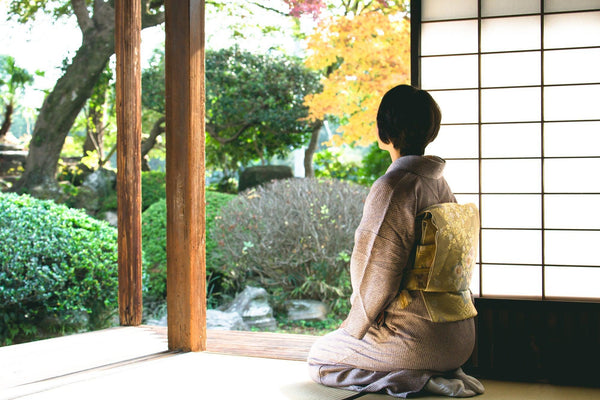
Jump to:
Picture an old ceramic bowl from Japan.
It sits modestly on a table, colors muted into an earthy hue by years of use and age. There are nicks along the rim of the bowl; and the glaze has thinned in spots, revealing the natural clay underneath.
To some people, this bowl might appear unremarkable, maybe even unsightly. But in the Japanese philosophy of wabi-sabi, this bowl would likely be revered for the imperfections and blemishes that showcase the beautiful path of its making.
That reverence stems from the concept of Wabi-Sabi.
Wabi-sabi is a core aesthetic principle in Japan. It’s about finding unexpected brilliance in the modest, aged and unconventional.
Wabi-sabi is a time-honored worldview that embraces impermanence and flaws as marks of authenticity and life's transient nature. Rather than shunning the old and imperfect, wabi-sabi sees purity and elegance therein.
In this article, we'll take a deeper look at the nuanced world of wabi-sabi and its enduring influence in Japan and beyond. You'll learn the distinct meanings behind the concepts of "wabi" and "sabi,” the philosophy's centuries-old origins and how it provides a stark contrast to modern Western perspectives on beauty. We'll even give a window into where you can experience wabi-sabi during your next trip to Japan.
What Is Wabi-Sabi? Why Is It Such An Important Japanese Concept?

At its core, wabi-sabi is the Japanese mindset of finding beauty in life's imperfections.
The wabi-sabi philosophy provides a counterpoint to typical Western ideals of perfection, newness and excess. While we often discard items at the first sight of a crack or stain, wabi-sabi teaches us to appreciate an object's journey and evolving character over time. Beauty is found in things that are unblemished, unassuming and unconventional.
More than just an artistic trend or design aesthetic, wabi-sabi is a venerated worldview derived from the spiritual and cultural traditions of Japan.
The Japanese concept of wabi-sabi is centered on the acceptance of transience and human nature's imperfect reality. Rather than perceiving flaws and signs of aging as ugly, the wabi-sabi philosophy gives them a place of revered appreciation.
An old, faded piece of Japanese pottery with cracks is celebrated for the elegant simplicity it has attained through its existence over decades or centuries.
This stands in stark contrast to typical Western mentalities that constantly chase after newness and idealized, mass-produced visions of perfection. We're conditioned to want the newest iPhone, the trendiest fashion items or a home filled with unblemished furniture and decor.
The wabi-sabi mindset instead finds humility and unexpected artistic poignancy in the naturally imperfect character of things. In wabi-sabi, there is beauty in the simple, modest and unassuming facets of life.
Wabi-Sabi & Wasabi: Foodie Confusion Untangled
Food fans familiar with Japanese cuisine might be wondering whether there’s any connection between wabi-sabi and wasabi, the pungent Japanese horseradish admired by sushi and soba lovers who like a little extra kick.
No, is the short answer; one has nothing to do with the other. In fact, they’re practically opposites!
Wasabi is a Japanese horseradish, pure and simple. Wabi and sabi, meanwhile, are Japanese words that have nothing to do with food. Let’s delve into the linguistic and historic meanings behind wabi and sabi.
Wabi & Sabi Defined: Rustic, Aged Charm

The Japanese aesthetic of wabi-sabi comprises two core concepts - wabi and sabi. Though related, each has its own distinct meaning in the Japanese language.
“Wabi” represents a rustic, understated form of elegance that avoids extravagance and embraces the authentic. It’s an unassuming grace that embraces the modest and humble. The wabi approach avoids anything ostentatious or over-designed in favor of an understated, pared-down authenticity.
One can find wabi embodied in handcrafted objects like the traditional pottery from Japanese villages. These are simple, earthen pieces shaped by human hands without gilded or superfluous decorations. The focus is on the object's pure functionality and form, celebrating its imperfections as unique artistic expressions.
The wabi spirit can also be seen in traditional Japanese architecture like the thatched-roof farmhouses of Gokayama or Hida-Takayama. These homes are constructed using humble, local materials and designed for functionality over luxury. Yet their weathered wood and rough-hewn elegance carry an inherent, unvarnished beauty.
Sabi, meanwhile, refers to the aesthetic love of the naturally aged, withered and decaying. Things that exhibit sabi beauty have acquired a lovely patina and character through the organic process of erosion and time's passage.
Classic sabi examples are the mossy, uneven stone pathways found in Japan's famous Zen gardens like Ryoan-ji in Kyoto. Rather than attempting to preserve the path's original, clean lines, the sabi appreciation celebrates the picturesque irregularity as nature takes its course.
Another embodiment of sabi is the Japanese art of kintsugi, where shattered ceramics are carefully mended back together using lacquer mixed with precious metals like gold or silver. This conscious celebration of the cracks and repairs as part of the object's history exemplifies the sabi philosophy.
Together, wabi's modest simplicity and sabi's reverence for the aged create the core tenets behind wabi-sabi. It’s a uniquely Japanese sense of imperfect, impermanent beauty. Where some folks would see unsightliness, the wabi-sabi viewer instead appreciates the gentle patina of moss taking over and the fading beauty in the gradual erosion process working its magic.
History Of Wabi-Sabi In Japanese Culture

The roots of wabi-sabi trace back over a millennium to the spiritual teachings of Zen Buddhism as they took hold in Japan.
Wabi-sabi’s reverence for simplicity, humility and acceptance of the natural cycle of life aligned well with Zen principles.
Zen Buddhist scholars and monks were largely responsible for the wabi-sabi worldview that provided a counterpoint to the lavish, ostentatious aesthetics favored by Japan's aristocratic class at the time. Instead, Zen wisdom taught that true beauty and enlightenment could be found in the unassuming and insignificant details often overlooked in pursuit of grandiose embellishment.
The ancient practice of chanoyu (tea ceremony) adopted rigorous wabi-sabi principles that celebrated imperfections in the ceremony's equipment and surroundings as emblematic of life's fleeting, unrefined beauty.
Under Rikyū, strict parameters for the Japanese tea ceremony's surroundings were set: Spare interior spaces assembled with minimal adornment using unfinished woods; along with handmade utensils designed for pure functionality, not lavishness. This pared-down, humble setting became known as “wabi cha” – and it provided the environment for participants to deeply appreciate the inherent beauty in life's modest, transient details.
From these Zen Buddhist foundations, the philosophical depth of wabi-sabi's concepts took root across many aspects of traditional Japanese culture and creative arts, from pottery, painting and literature to architecture, gardening and more.
Wabi-sabi's ideals became interwoven into many traditional Japanese arts and practices. It influenced the rustic ceramic pieces and asymmetric household items produced by Japan's folk craft movement.
The wabi-sabi influence remains thoroughly embedded in the Japanese way of life today.
How And Why Did the Concept Of Wabi-Sabi Become Popular In The West?

While wabi-sabi developed centuries ago as a deeply spiritual philosophy in Japan, the concept didn't gain widespread awareness in Western culture until more recent times.
The first inklings came in the late 19th century as Japanese pottery and ceramic arts with their rustic, imperfect aesthetics were exhibited in Europe.
However, it wasn't until the 1950s and 60s that wabi-sabi's underlying principles started resonating more broadly with the Western cultural psyche. Beat writers and poets like Jack Kerouac and Gary Snyder were drawn to Zen Buddhism's teachings and began exploring ideas around nonattachment, living simply and rejecting societal norms of consumerism.
An appreciation for the wabi-sabi aesthetic and its broader life teachings steadily grew in the West through the 1970s and 1980s. Books exploring the Japanese concepts hit shelves and designers began incorporating wabi-sabi principles into interior decor, furniture, pottery and more.
Today's widespread adoption of wabi-sabi style across design disciplines stems largely from this period when the concept took root in Western consciousness.
How Are The Japanese And Western Meanings Of Wabi-Sabi Different?
Though the wabi-sabi philosophy has found appreciation in the West, there are distinct differences in how the concept is understood compared to its origins in Japan.
At its core in Japanese culture, wabi-sabi represents an all-encompassing worldview and spiritual mindset. In the West, it is more commonly viewed through a narrower lens of just an aesthetic design principle.
In Japan, the profound depth of wabi-sabi is inextricably tied to the Buddhist teachings of impermanence (“mujo”) and the nature of existence as a constant cycle of birth, decay and rebirth.
The philosophy provides a coping mechanism to accept transience and find beauty in life's fleeting, unrefined reality. An asymmetrical, handmade ceramic bowl embodies the wabi-sabi ideals because its imperfections truthfully capture the humble human touch and impermanent creative process required to craft it.
One might say that Westerners have largely embraced wabi-sabi's visual qualities without fully internalizing its deeper underpinnings.
While Japanese philosophers have long pondered the spiritual enlightenment found in wabi-sabi's appreciation of aging and entropy, Western audiences tend to be more captivated by wabi-sabi’s bucolic, rustic charm as an interior design trend.
Where Can You Experience Real Examples Of Wabi-Sabi in Japan?
For travelers to Japan seeking to experience the wabi-sabi aesthetic firsthand, numerous opportunities abound across the country to immerse yourself in this celebrated philosophy of imperfect, impermanent beauty.
From ancient temples and shrines to handcrafted pottery villages and manicured gardens, wabi-sabi's principles create indelible moments of life's unrefined yet profound artistry.
Ryoan-ji Temple

One of the most iconic destinations is Kyoto's Ryoan-ji Temple, home to one of Japan's most famous rock gardens. Here, wabi-sabi is encapsulated in the Zen garden's carefully curated natural designs. Pockets of raked gravel create a sense of perpetual movement and fluidity, while strategically placed rocks develop an ever-evolving patina of moss growth exhibiting nature's ephemeral sabi beauty. The garden serves as an invitation to appreciate simplicity while pondering life's transient complexities.
Kinkaku-ji (the Golden Pavilion)

On the other side of Kyoto, the fading brilliance of Kinkaku-ji (the Golden Pavilion) provides another exquisite example of the sabi half of wabi-sabi. This Zen Buddhist temple's top two floors are coated in radiant gold leaf. However, rather than attempting to preserve its original lustrous veneer, wabi-sabi celebrates the structure's gradual, melancholic aging and deterioration over centuries as the gold's brilliance gently mutes and fades according to nature's slow but inevitable cycle.
Hida Folk Village

To gain a more grounded perspective of wabi-sabi's appreciation for humble, everyday craft and lifestyle, visitors can travel to preserved villages like Hida Folk Village in Gifu Prefecture. Here, traditional farmhouses assembled from unfinished wood and humble materials like thatched roofing showcase the wabi ideals of simplicity and eschewing excess.
Mashiko Town

The town of Mashiko in Tochigi Prefecture is yet another stellar destination for witnessing the wabi-sabi aesthetic infused into Japan's renowned ceramics and pottery traditions. Master artisans here still follow ancient approaches handed down over generations, handcrafting elegant but simple pieces that highlight the beauty of imperfections and the human hand's natural asymmetries. From the picking of regional clay to the perfectly imperfect final kintsugi repair of any cracks, the entire pottery-making process embraces the wabi-sabi spirit.
Wabi-Sabi: Embracing Imperfection In Japan & Around The World
At first glance, the Japanese philosophy of wabi-sabi can seem contradictory to modern Western perspectives that relentlessly pursue idealized notions of perfection, newness and permanence.
How can we find beauty and artistic merit in the old, withered and imperfect?
And yet, the more we lean into the nuanced wisdom of wabi-sabi's teachings, the more its profound truths come into focus.
By changing our lens to appreciate simplicity, authenticity and the inherent nature of impermanence, we can access an unexpectedly rich universe of aesthetic enlightenment in the modest, aged and unconventional elements that surround us every day.
From the handcrafted pottery piece proudly displaying its makers' thumbprints, to the crumbling, moss-covered step carrying centuries of stories, to the fading natural brilliance of a setting sun – the wabi-sabi perspective allows us to find humbled awe in the most unassuming details.
Have you experienced wabi-sabi in Japan or elsewhere? Tell us about your experiences in the comments section below!


0 comments